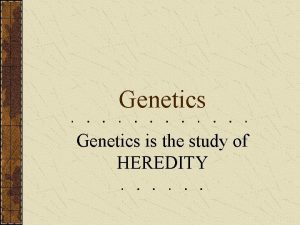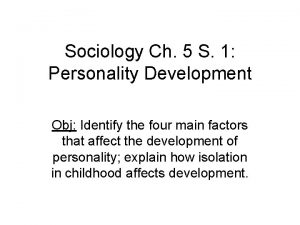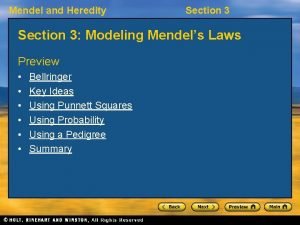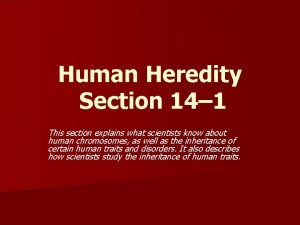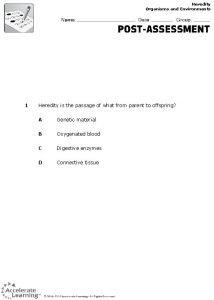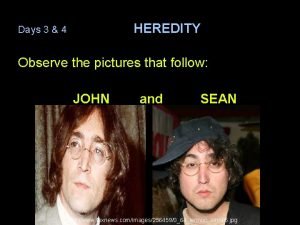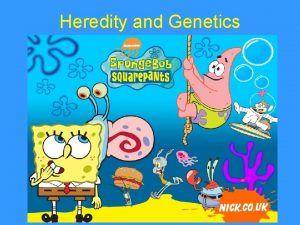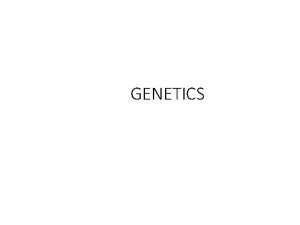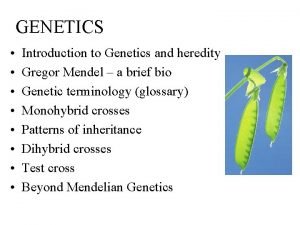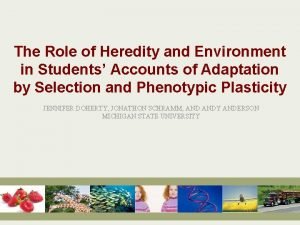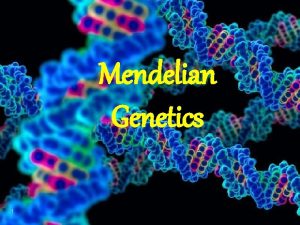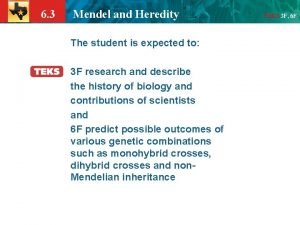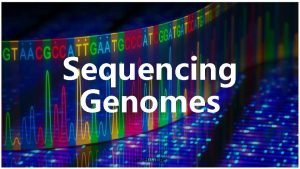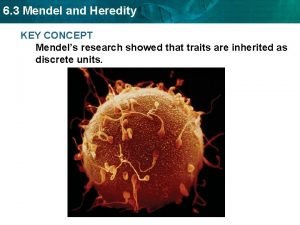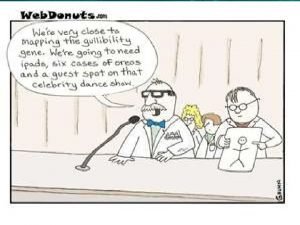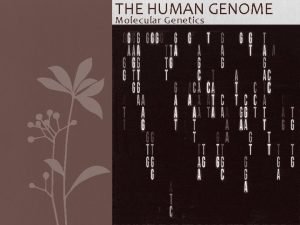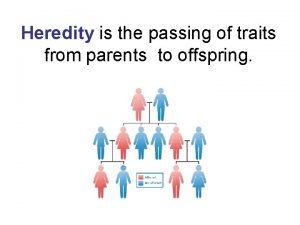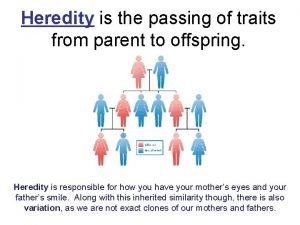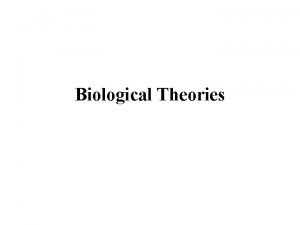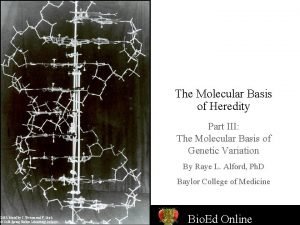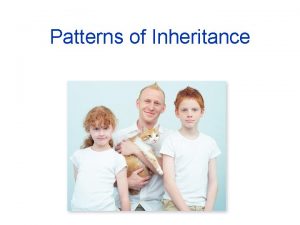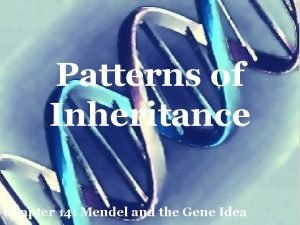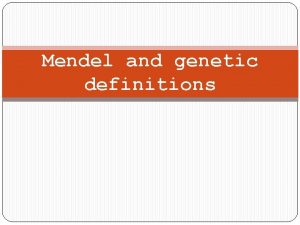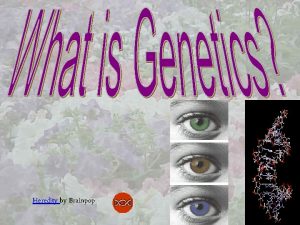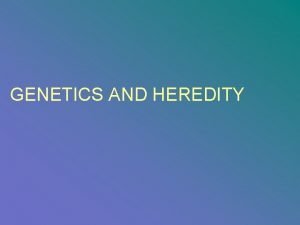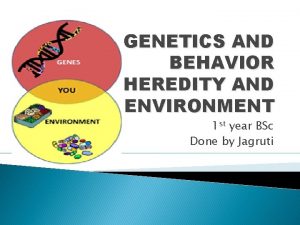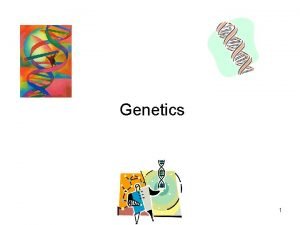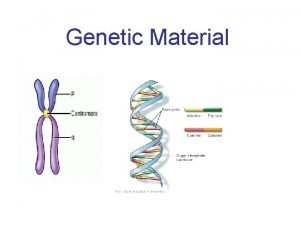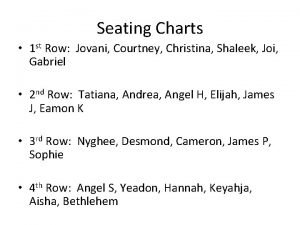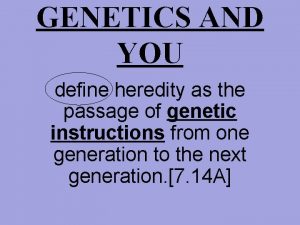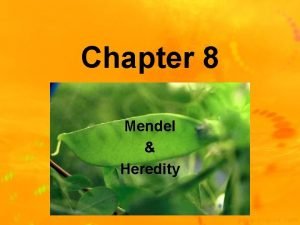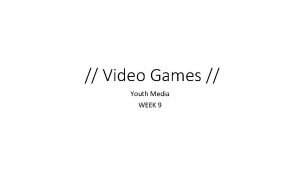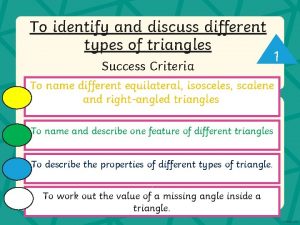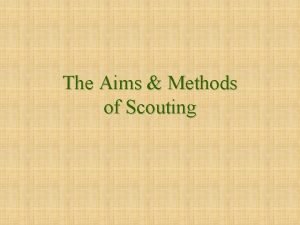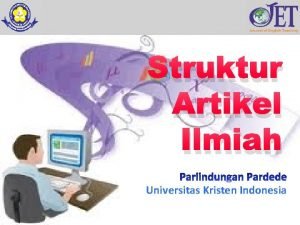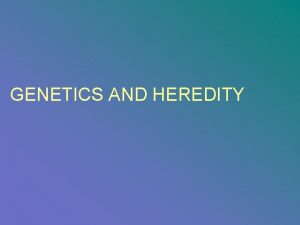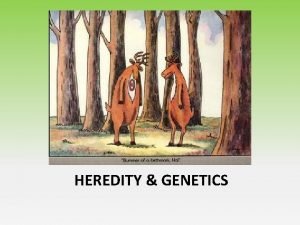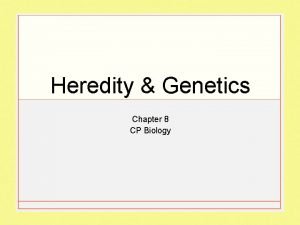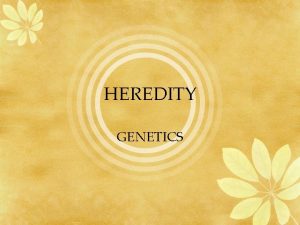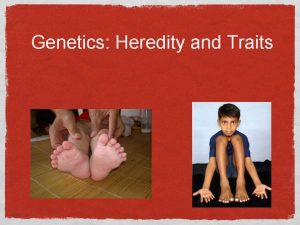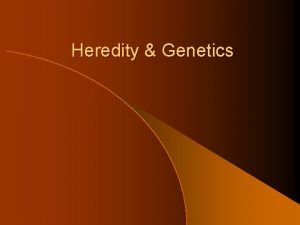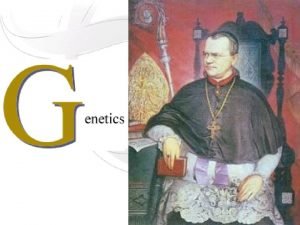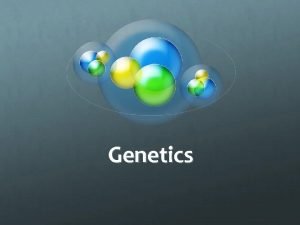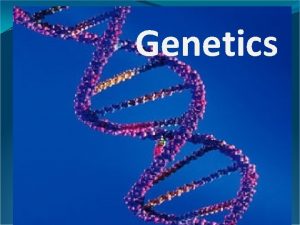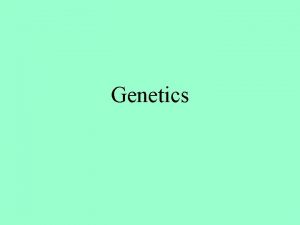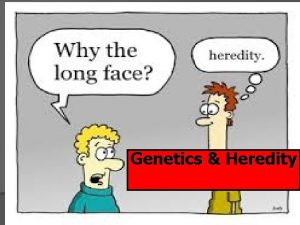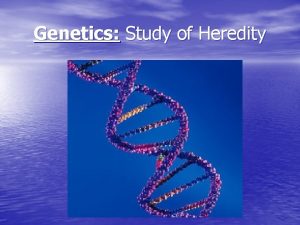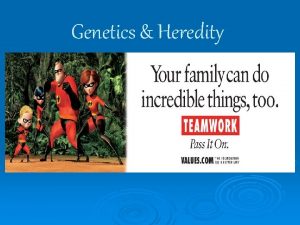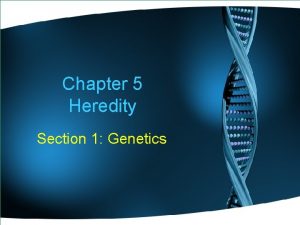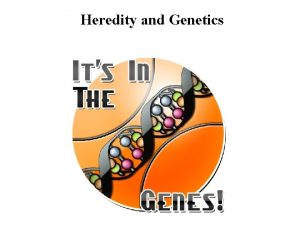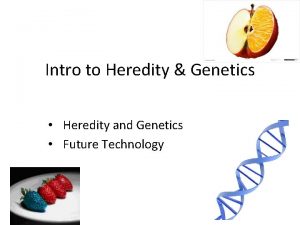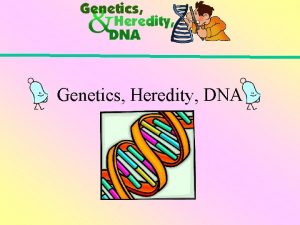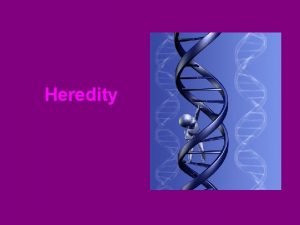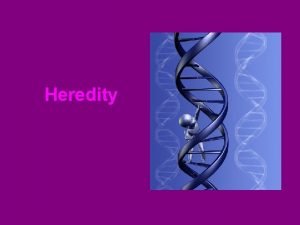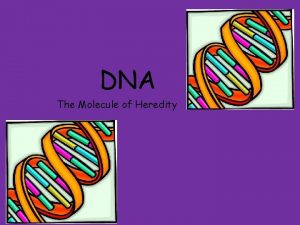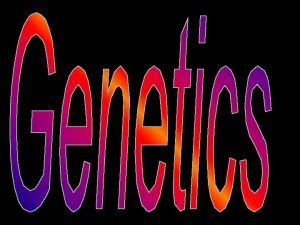Genetics Study of Heredity Aim What is Genetics


























































- Slides: 58

Genetics: Study of Heredity

Aim: What is Genetics? http: //www. youtube. com/watch? v=e. Ov. MNOMRRm 8

Sexual Reproduction: • Two parents • Half of the genetic information is received from one parent, half from the other. • Variation Evolution

Asexual Reproduction: • One parent • Offspring is identical to parent. • Clones- identical genetic copies.

Types of Asexual Reproduction • Fission: To split or divide (Protist) • Budding: Swelling that develops into a new identical organism (Hydra) • Vegetative Reproduction (Potatoes)

Genetics: • Gregor Mendel- 1800’s • “Father of Genetics” • Pea plants: easy to grow • Contrasting traits • Easily self and cross pollinate. • From his studies, Mendel arrived at conclusions that are the basis for genetics today!

Additional Vocabulary • Genetics: Study of heredity • Heredity: Passing of genetic information from an organism to it’s offspring.

• Genes: units of heredity – Determines traits/ characteristics an offspring will have. – Located on chromosomes. – For each trait-> minimum of 2 genes. One from mom, one from dad. • There are many genes located on a Chromosome.

Genes

Hereditary Information: • DNA- deoxyribonucleic acid • Organic (C, H, O, N, P). • Double stranded • Organized in the form of genes located on the chromosomes.

Hereditary Information: cont. • Homologous chromosomes- are same size and shape (one from each parent) – This allows for crossing over and variation to occur. http: //www. youtube. com/watch? v=l. Jz. Z 7 p-47 P 8


Genotype vs. Phenotype: Genotype- genes Ex: B, b, S, s Phenotype-Physical appearance Ex: Fur Color, Fur Length http: //www. youtube. com/watch? v=j. HWJqzl. Hl 3 w

Genetic Recombination: • Sperm and egg combine to form a new cell. • New cell (offspring) has a complete set of genetic information (DNA). Each offspring is unique.

The Genetic Code: – Structure of DNA was discovered by 2 scientists: – 1953 James Watson and Francis Crick – Created a model known as the Double Helix a twisted ladder.

What is the structure of DNA?


Structure of DNA • Long chain of repeating units ( polymer) called • nucleotides. A nucleotide unit contains: 1. phosphate group O 2. deoxyribose (sugar) 3. nitrogenous base: – A- adenine – T- thymine – C- cytosine – G- guanine

Structure of DNA

One Strand of DNA • The backbone of the molecule is alternating phosphate and deoxyribose, a sugar, parts. • The teeth are nitrogenous bases. phosphate deoxyribose bases

Two Stranded DNA • Remember, DNA has two strands that fit together something like a zipper.

Types of nitrogen bases • A= adenine • G= guanine • C= cytosine • T= thymine

Structure of a Double Helix • Sides of the “ladder” are • • alternating phosphate group and deoxyribose sugar. “rungs” of the ladder are made of 2 nitrogenous bases. Specific pairings: – There is a weak Hydrogen bond Between the base pairs. – Structure as a double helix – When a cell goes through mitosis(cell division) the DNA must also make a copy of itself.

DNA by the numbers • Each cell has about 2 • • • m of DNA. The average human has 75 trillion cells. The average human has enough DNA to go from the earth to the sun more than 400 times. DNA has a diameter of only 0. 00002 m. The earth is 150 billion m or 93 million miles from the sun.

Aim: How does DNA replicate? Do Now: Please answer the questions on the handout found on the front desk, omit questions 5 -7.

Genetics Can Tell All G-Guanine C-Cytosine T-Thymine A-Adenine

Base Pairing • Which bases always • • match up? A-T G-C Adenine always binds with Thymine Cytosine always binds with Guanine

Steps of Replication: 1. DNA unwinds 2. DNA unzips 3. Old strands become templates for new strands 4. Result- 2 identical DNA molecules



Characteristics of a Double Helix • Proteins and Cell Functioning: – Proteins- long chains formed from 20 kinds of amino acids. – Sequence(order) of the amino acids influences the shape of the molecule. – Proteins include: enzymes, insulin, eye color, and skin color.


DNA- Protein Connection: – Genes contain coded information. – This information is used to make proteins that are required for it’s function and structure. – Ribosomes construct proteins based on the cell’s DNA code (combo of A, C, T, G’s). – Parent and offspring produce similar traits that is why there is resemblance between them. They produce similar proteins.


Aim: How does protein synthesis Work?

Protein Synthesis: • The building of protein molecules. • Synthesizing protein from DNA. • Proteins are chains of amino acids.

Steps: – Begins in the nucleus with DNA. – DNA code is read by a “ messenger molecule” messenger RNA; ; – m. RNA. – “messenger molecule: travels into the cytoplasm of the cell to the ribosome.

Steps cont. : – With the help of “transfer molecules” t. RNA amino acids move to the ribosomes to make proteins. – The ribosomes “reads” the code and a chain of amino acids is produced forming a protein. – ***Protein structure is determined by DNA***


RNA: • Ribonucleic Acid • Single stranded • Nitrogenous bases – A- adenine – U- uracil – C- cystosine – G- guanine

Types of RNA – Messenger RNA (m. RNA) Copies code from DNA Brings to ribosome – Transfer RNA (t. RNA) Brings amino acids to ribosome for protein assembly – Mutations: Alteration of DNA sequence. Causes a change in code carried for by the gene. Random, but can be increased because of chemicals, radiation.

Aim: What are different genetic mutations? • Do Now: Please complete the handout on the front desk.



Different Types of Mutations: • Original DNA Template C A A T G C T A C – 1. Substitution: one base pair for another. CAACGCTAC – 2. Deletion: missing a base. CAATOCTAC – 3. Addition: adding an extra base CAATAGCTAC – 4. Inversion: bases are rearranged. CAGATCTAC



Causes of Mutations • Environmental Conditions can affect how genes are expressed. – Ex. Himalayan rabbit – Warmer body temperature white fur – Colder body temperature black fur • ** Identical twins- separated- different • personalities Chemicals, hormones can activate a gene, causing certain proteins to be produced.

Genetic Engineering • Used to alter instructions in organisms. • Produce more desirable traits.

Selective Breeding: • Produces animals and plants with desirable traits. • Horse & donkey= mule. (outbreeding) • Ex. Larger, juicier fruits… • Pure dog, pure cat. (inbreeding)

Inbreeding/ Outbreeding

Breeding continued: • ** In sexually reproducing organisms only mutations found on sex cells can be inherited by the offspring. • Mutations occurring in body cells will only affect that organism.

DNA and Individuality: • The order of the nitrogenous base pairs, • • A, T, C, G’s are what makes each person an individual and unique. This is because the order allows for certain proteins to be produced. In an organism every cell contains the same genetic code. However, each cell is different: hair cells, skin cells, liver cells, stomach cells.

Gene Expression. • Each cell only uses some of the genetic information from the chromosomes. • Certain parts of the chromosomes get “turned on” or “turned off. ”

Gene Manipulation: • Altering genes using enzymes • By manipulating the DNA in plant cells or animal cells; favorable offspring can be produced • Produce bacteria that can be beneficial.

Steps: • Cut DNA segment with enzymes • This segment can be spliced (moved) and attached to DNA of a new organism. • New organism will make the protein coded for by DNA code.

Gene Manipulation

Biotechnology: • Apply technology to biology. • Applications of Biotechnology: – By using gene therapy and applying it to modern medicine scientists may: – Produce hormones, enzymes and other body chemicals. – Provide at a low cost. – Provide a purer form.
 Intermediate inheritance
Intermediate inheritance Chapter 17 lesson 2 heredity and genetics
Chapter 17 lesson 2 heredity and genetics ____________ is the study of heredity.
____________ is the study of heredity. Mendelian genetics vocab
Mendelian genetics vocab Chapter 7 extending mendelian genetics answer key
Chapter 7 extending mendelian genetics answer key Genetic vocabulary worksheet answer key
Genetic vocabulary worksheet answer key Heredity characteristics include body build
Heredity characteristics include body build Heredity concept map
Heredity concept map Section 3 mendel and heredity
Section 3 mendel and heredity Section 14-1 human heredity
Section 14-1 human heredity Heredity is best described as the -
Heredity is best described as the - Pictures of heredity
Pictures of heredity Allele
Allele Heredity
Heredity Inheritance vs heredity
Inheritance vs heredity Chapter 11 human heredity section 11-3
Chapter 11 human heredity section 11-3 Chapter 11 complex inheritance and human heredity test
Chapter 11 complex inheritance and human heredity test Chromosome labeled
Chromosome labeled Importance of heredity and environment in education
Importance of heredity and environment in education Section 3 mendel and heredity
Section 3 mendel and heredity Heredity terminology
Heredity terminology What are the basic units of heredity
What are the basic units of heredity Extra x
Extra x Section 3 mendel and heredity
Section 3 mendel and heredity Heredity torrent
Heredity torrent Section 3 mendel and heredity
Section 3 mendel and heredity Section 3 mendel and heredity
Section 3 mendel and heredity Heredity
Heredity Heredity
Heredity Heredity
Heredity Heredity and crime
Heredity and crime 45 chromosomes
45 chromosomes Molecular basis of heredity
Molecular basis of heredity Early ideas about heredity
Early ideas about heredity Dice and coin
Dice and coin Heredity
Heredity Unit 8 lesson 4
Unit 8 lesson 4 Brainpop heredity
Brainpop heredity What is a pheontype
What is a pheontype Difference between heredity and environment slideshare
Difference between heredity and environment slideshare Heredity acrostic
Heredity acrostic Heredity
Heredity Susie roundpants
Susie roundpants Heredity is the passage of
Heredity is the passage of Heredity
Heredity Case series
Case series Retrospective cohort study vs prospective cohort study
Retrospective cohort study vs prospective cohort study Critical examination in method study
Critical examination in method study Marty lobdel
Marty lobdel Phytogeography region of india
Phytogeography region of india Differentiate between time study and motion study
Differentiate between time study and motion study Distinguish between time study and motion study
Distinguish between time study and motion study Dollz aim
Dollz aim Slds aim
Slds aim Construction of transformer
Construction of transformer Aim triangle
Aim triangle The aims of scouting
The aims of scouting Aim suffix
Aim suffix Struktur penulisan airdam
Struktur penulisan airdam


